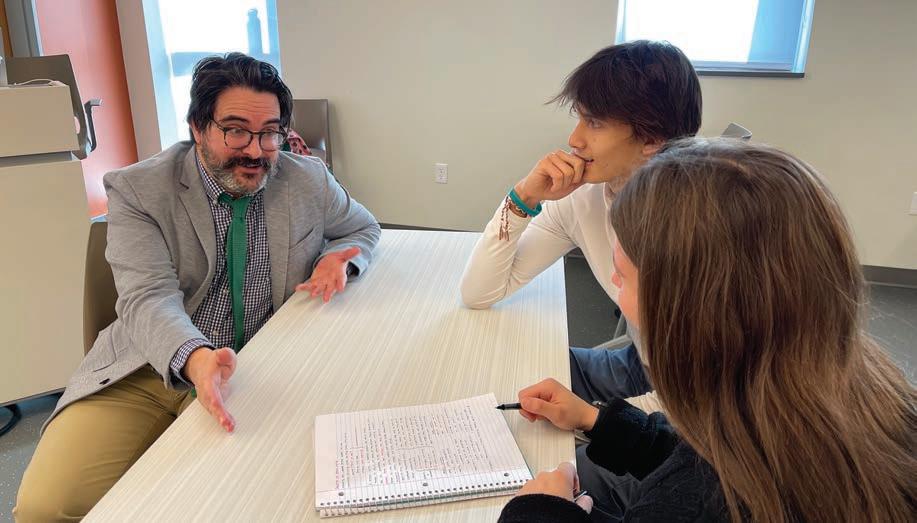
4 minute read
Catholic Social Ethics by Dr. Marc Lavallee
YOU ARE WHAT YOU EAT: CONSUMPTION AND CATHOLIC ETHICS
by Dr. Marc Lavallee
When I was growing up, there was a “Time for Timer” PSA during Saturday morning cartoons that sang, “You are what you eat.” I thought the depiction of the body as a processing factory for building muscle and tissue was the cleverest idea: what you put into your body makes up who you are. For Roman Catholics this concept has a special significance, for every time we attend Mass we consume the Holy Eucharist, Christ’s precious body and blood. If we are what we eat, then the Eucharist brings us into the life of God and the life of the community of disciples, Christ’s body the church. The idea that we are what we eat – that persons become what they consume – also has social significance, particularly among consumer cultures, and so each term my Sixth Form Catholic Social Ethics classes analyze their own practices of consumption.
Each term in Catholic Social Ethics, we engage in an activity that comes from my experience as a Benedictine monk. At the beginning of Lent, each monk would provide his abbot with a list of the things he personally owned as a way of thinking about his relationship with material goods. For our class activity, we make a list of everything we own, categorized and counted, as well as try to figure out where some of those items were made. The purpose of the activity is not to feel bad (or proud) about the things we own, but rather to try to get a sense of how many things we have, our relationship with those things, and our consequent relationship with the people who make those things. Our consumption puts us into relationship with persons, societies, and structural forces all around the world. It is inescapable – we must consume to live, and we thereby depend on people sometimes half a world away whom we likely will never meet or know anything about. For the Catholic tradition, matter is good, material things are good; they are created by God for the well-being and flourishing of human persons. But while we have become more and more dependent on material goods not only for our physical needs but also – perhaps more so – for the development of our personal identities and sense of self often in an almost spiritual sense, we have simultaneously become distanced from the actual, physical nature of material goods, their production, their producers, and the Earth itself. The great Jesuit poet, Gerard Manley Hopkins, recognized this when he wrote: “the soil / Is bare now, nor can foot feel, being shod.”
Students’ experiences of this class activity and subsequent discussion varies, but most students tend to find it at least a little eyeopening. Most students note that it is difficult to take stock of everything they own (“I never realized I had so much stuff!”). Some find that it motivates them to think about what things are most important to them (“I’m going back to my room and donating/selling anything I haven’t worn in four months”). Many students have difficulty simply finding out where their products are made, or are surprised when they found out where they were made (“it took me forever to find out where my Forever 21 dress was made,” or “I can’t believe the American flag in my room was made in China”). Finally, students begin to ask the difficult ethical ques-
tions regarding how well – or not well – the human beings who make our products are treated (we simply don’t know). We always also discuss what things are the most meaningful for us, because created things are good, useful, and beautiful. Personally, this is my favorite part of the activity, because I get to learn about my students’ treasured items that hold sentimental value (old stuffed animals, family heirlooms, letters, cards, etc.) or things that reveal how they spend their time and money most (a book, sports equipment, their phone – an important device for communicating easily with friends and family).
Ultimately, the activity develops on an affective level students’ knowledge of two significant elements of Catholic theology: sacramental imagination and social ethic. The activity develops students’ sense of Catholic sacramental imagination, that matter has meaning, as Catholic theologian Roberto Goizueta has written: “One cannot love the universal and supernatural if one cannot love the particular and natural.” And the activity develops students’ sense of the implicit social ethic of sacramental imagination: that humans are interconnected and responsible to each other, that we depend on each other, and that the authentic flourishing of human persons, as well as our shared planet, should be at the center of consumer economics.
a
Dr. Lavallee is head of the Department of Theology at Portsmouth Abbey School. His teaching focuses on Christian theology, spiritual practices, social ethics, service learning, and the intersection of religion and culture covering historical and contemporary practices of lived faith across the globe. He is head of Community Service and lives on campus as an assistant houseparent in St. Martin’s with his wife, Katie Blais, and sons Henry and Augustin (Gus). Read more about Dr. Lavallee on the Portsmouth Abbey School website.










